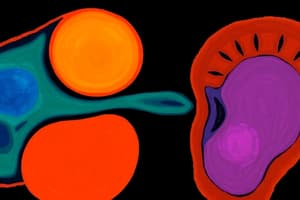Podcast
Questions and Answers
Why is cleavage a crucial process in early embryonic development?
Why is cleavage a crucial process in early embryonic development?
- To immediately form organs and tissues in the developing embryo.
- To enable the zygote to differentiate into specialized cell types.
- To allow the zygote to increase in size and volume.
- To overcome the shape limitations of a single large cell and prepare for differentiation. (correct)
Which of the following accurately describes cleavage in the context of early embryonic development?
Which of the following accurately describes cleavage in the context of early embryonic development?
- The formation of organs from the primary germ layers.
- The process of cell growth and enlargement of the zygote.
- Rapid cell division of the zygote into numerous smaller cells without increasing overall size. (correct)
- The differentiation of the zygote into ectoderm, mesoderm, and endoderm.
In what chronological order do the key events of early vertebrate development occur, based on the provided information?
In what chronological order do the key events of early vertebrate development occur, based on the provided information?
- Organogenesis, Cleavage, Formation of primary germ layers
- Cleavage, Formation of primary germ layers, Organogenesis (correct)
- Formation of primary germ layers, Organogenesis, Cleavage
- Formation of primary germ layers, Cleavage, Organogenesis
What is the primary significance of the formation of the three primary germ layers during embryonic development?
What is the primary significance of the formation of the three primary germ layers during embryonic development?
Which of the following correctly describes the relative positions of the primary germ layers in an early embryo, from outermost to innermost?
Which of the following correctly describes the relative positions of the primary germ layers in an early embryo, from outermost to innermost?
Organogenesis, the formation of organs, is directly enabled by which preceding event in embryonic development?
Organogenesis, the formation of organs, is directly enabled by which preceding event in embryonic development?
Why is the formation of primary germ layers considered a crucial step that must precede organogenesis in embryonic development?
Why is the formation of primary germ layers considered a crucial step that must precede organogenesis in embryonic development?
Which of the following is a key distinction between sexual and asexual reproduction?
Which of the following is a key distinction between sexual and asexual reproduction?
What is the correct sequence of events in sexual reproduction?
What is the correct sequence of events in sexual reproduction?
Oogenesis and spermatogenesis are processes that directly result in the formation of what?
Oogenesis and spermatogenesis are processes that directly result in the formation of what?
A researcher is studying a species of fish that reproduces via external fertilization. Which of the following observations would support this mode of reproduction?
A researcher is studying a species of fish that reproduces via external fertilization. Which of the following observations would support this mode of reproduction?
Which of the following features is characteristic of hermaphroditic animals?
Which of the following features is characteristic of hermaphroditic animals?
Why do developmental biology experiments often utilize non-human organisms?
Why do developmental biology experiments often utilize non-human organisms?
What is the role of the anteroposterior axis in early vertebrate development?
What is the role of the anteroposterior axis in early vertebrate development?
Which axis is responsible for organizing the back and belly of an organism during early development?
Which axis is responsible for organizing the back and belly of an organism during early development?
Flashcards
Sexual Reproduction
Sexual Reproduction
Reproduction involving two parents producing offspring with unique gene combinations.
Asexual Reproduction
Asexual Reproduction
Reproduction from a single parent creating a clone through mitosis.
Gametes
Gametes
Specialized sex cells (sperm and ova) produced for sexual reproduction.
Sperm
Sperm
Signup and view all the flashcards
Ova
Ova
Signup and view all the flashcards
Zygote
Zygote
Signup and view all the flashcards
Hermaphrodites
Hermaphrodites
Signup and view all the flashcards
Anteroposterior Axis
Anteroposterior Axis
Signup and view all the flashcards
Dorsoventral Axis
Dorsoventral Axis
Signup and view all the flashcards
Cleavage (embryology)
Cleavage (embryology)
Signup and view all the flashcards
Why is cleavage important?
Why is cleavage important?
Signup and view all the flashcards
Primary Germ Layers
Primary Germ Layers
Signup and view all the flashcards
Ectoderm
Ectoderm
Signup and view all the flashcards
Mesoderm
Mesoderm
Signup and view all the flashcards
Endoderm
Endoderm
Signup and view all the flashcards
Study Notes
-
There are two fundamental methods that organisms use to reproduce:
- Asexual reproduction is reproduction from a single parent that creates a clone through mitosis
- Sexual reproduction is when two parents produce offspring with unique combinations of genes from both parents
-
Some multicellular animals use both asexual and sexual reproduction, while others only reproduce sexually
-
The sequence of events in sexual reproduction starts with gametogenesis, the formation of gametes
-
Gametes are specialized sex cells produced by each parent and there are two types: sperm and ova
-
Sperm, the male gametes, are created during spermatogenesis
-
Ova, the female gametes, are created during oogenesis
-
After gametogenesis, sperm and ova combine to form a zygote, a fertilized ovum
-
Fertilization can occur externally outside the bodies of both parents or internally inside the female
-
Early development of the offspring can also occur internally or externally
-
Some animals, like common garden snails, are hermaphrodites, organisms that have both male and female sexual organs
-
Hermaphrodites still reproduce sexually by cross-fertilizing each other's ova
-
After fertilization, the zygote must establish the three major body axes:
- The anteroposterior axis organizes the body from head to tail
- The dorsoventral axis organizes the body from back to belly
- The left-right axis organizes the body from left to right
-
Next, the zygote must undergo cleavage, the process by which the zygote rapidly divides without growing to become multicellular
-
Cleavage occurs early because a single cell is limited in the shapes it can form, and a single-celled zygote cannot begin differentiating into different tissue types
-
The formation of the three primary germ layers must be completed during early development, these three layers are: the ectoderm, the mesoderm and the endoderm
-
The ectoderm is the outermost layer of cells in the early embryo
-
The mesoderm is the middle layer of cells in the early embryo
-
The endoderm is the innermost layer of cells in the early embryo
-
Each primary germ layer will eventually become a specific set of tissue and cell types of the organism, so the formation of the different layers is one of the critical early events in animal development
-
After the three primary germ layers are formed, organogenesis, or the formation of organs, can begin in the embryo, and the different body structures can begin to take form
Studying That Suits You
Use AI to generate personalized quizzes and flashcards to suit your learning preferences.




